Table of Contents
- Introduction
- Editor’s Choice
- Global Diabetic Food Market Overview and Statistics
- Prevalence of Diabetes in Various Nations Statistics
- Diabetic Food Nutritional Value of Foods Recommended Statistics
- Recommended Calorie Intake for Individuals
- Retail Sales Value of Digestive and Diabetic/Dietetic Food Products Statistics
- Diabetic Food with a Low-Glycemic Index Recommended Statistics
- Benefits of Diabetic Food Consumption Statistics
- Recent Developments
- Conclusion
- FAQs
Introduction
Diabetic Food Statistics: Diabetic food involves careful carbohydrate monitoring, portion control, and emphasis on fiber-rich foods like vegetables and whole grains to stabilize blood sugar levels.
Lean proteins such as poultry and fish, along with healthy fats from sources like avocados and nuts, should be incorporated into meals for satiety and improved insulin sensitivity.
Limiting added sugars and sweets, adhering to regular meal timing, and staying hydrated with water are essential practices.
Individuals are advised to work with healthcare professionals to develop personalized meal plans, monitor blood sugar levels regularly, and make informed dietary choices to manage diabetes effectively.
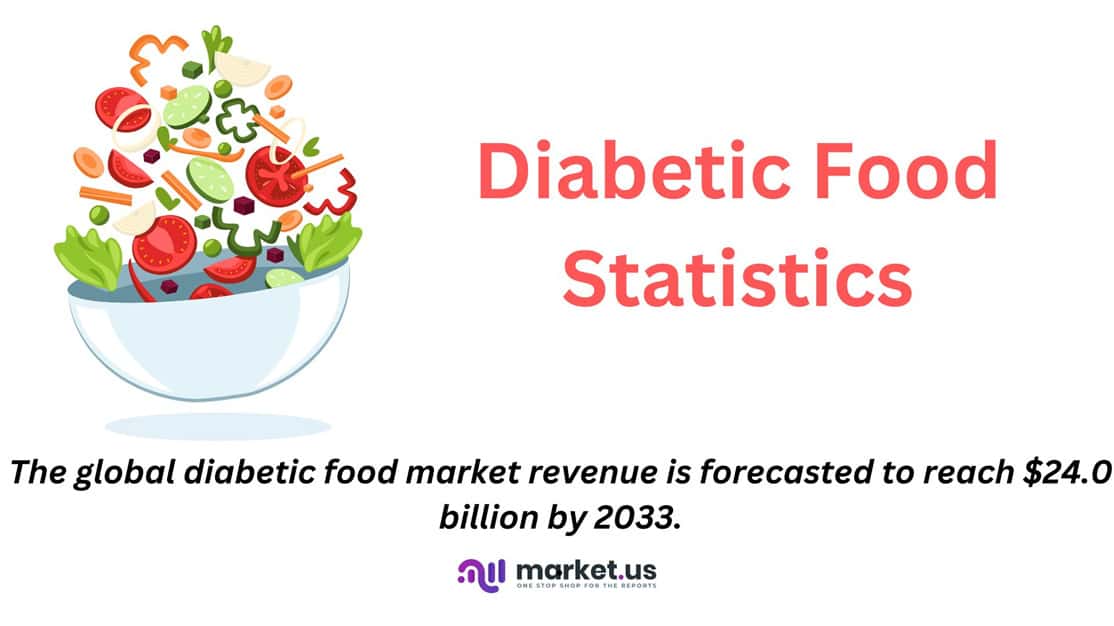
Editor’s Choice
- By 2033, the global diabetic food market is forecasted to achieve revenues of USD 24.0 billion.
- North America holds the largest market share, accounting for 37.5% of the total market, driven by factors such as a high prevalence of diabetes and increasing consumer awareness regarding healthy dietary choices.
- In the competitive landscape of the diabetic food market, the Kellogg Company leads with an 18% market share.
- At the forefront of the diabetes concern is Pakistan, where a staggering 30.8% of the population falls within the diabetic demographic.
- Generally, experts advise following a daily diet plan ranging from 1200 to 1500 calories to help manage blood glucose levels and maintain a healthy weight. However, these recommendations may differ for each person.
- In 2019, the packaged bakery and cereals industry emerged as the primary driver of U.S. retail success, registering the most substantial sales for digestive health and diabetic/dietetic products, totaling approximately 6.9 billion U.S. dollars.
- According to research published in PLoS Medicine involving over 200,000 participants in the U.S. over 20 years, individuals who predominantly consumed plant-based diets were 20% less likely to develop type 2 diabetes compared to others in the study.
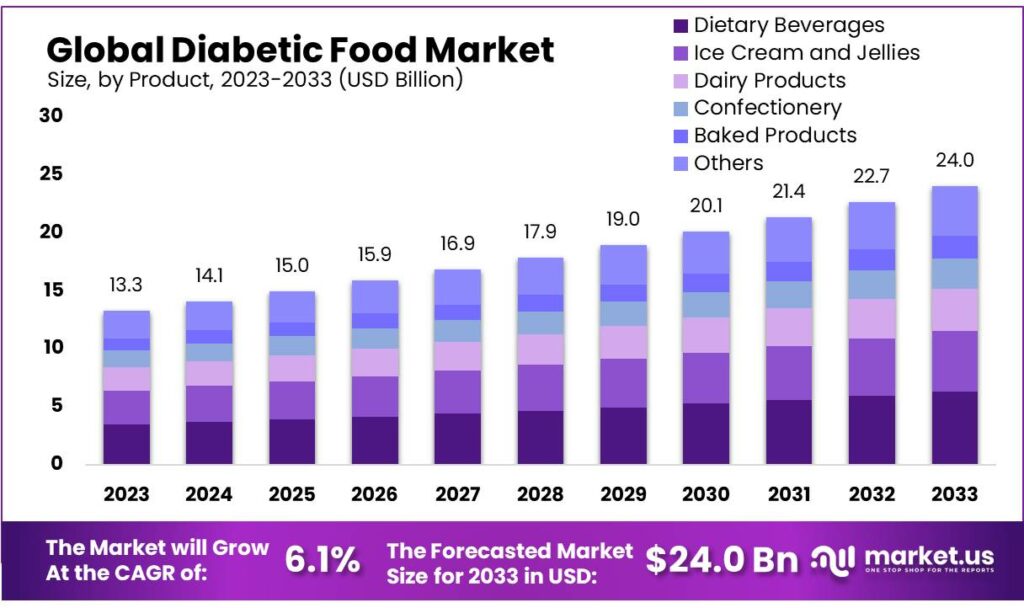
Global Diabetic Food Market Overview and Statistics
Global Diabetic Food Market Basics Statistics
- The global diabetic food market has witnessed steady revenue growth over the past decade, with a CAGR of 6.1%, with revenues reaching USD 13.3 billion in 2023 and projected to increase to USD 14.1 billion in 2024.
- This growth trajectory is expected to continue, with revenues forecasted to reach USD 15.0 billion in 2025, USD 15.9 billion in 2026, and USD 16.9 billion in 2027.
- By 2030, the market is anticipated to surpass the USD 20 billion mark, with revenues reaching USD 20.1 billion.
- Subsequent years are projected to see continued expansion, with revenues expected to climb to USD 21.4 billion in 2031 and USD 22.7 billion in 2032.
- By 2033, the global diabetic food market is forecasted to achieve revenues of USD 24.0 billion, reflecting sustained growth driven by factors such as rising diabetes prevalence, increasing health consciousness, and the demand for convenient yet healthy snack options among diabetic individuals.
(Source: Market.us)
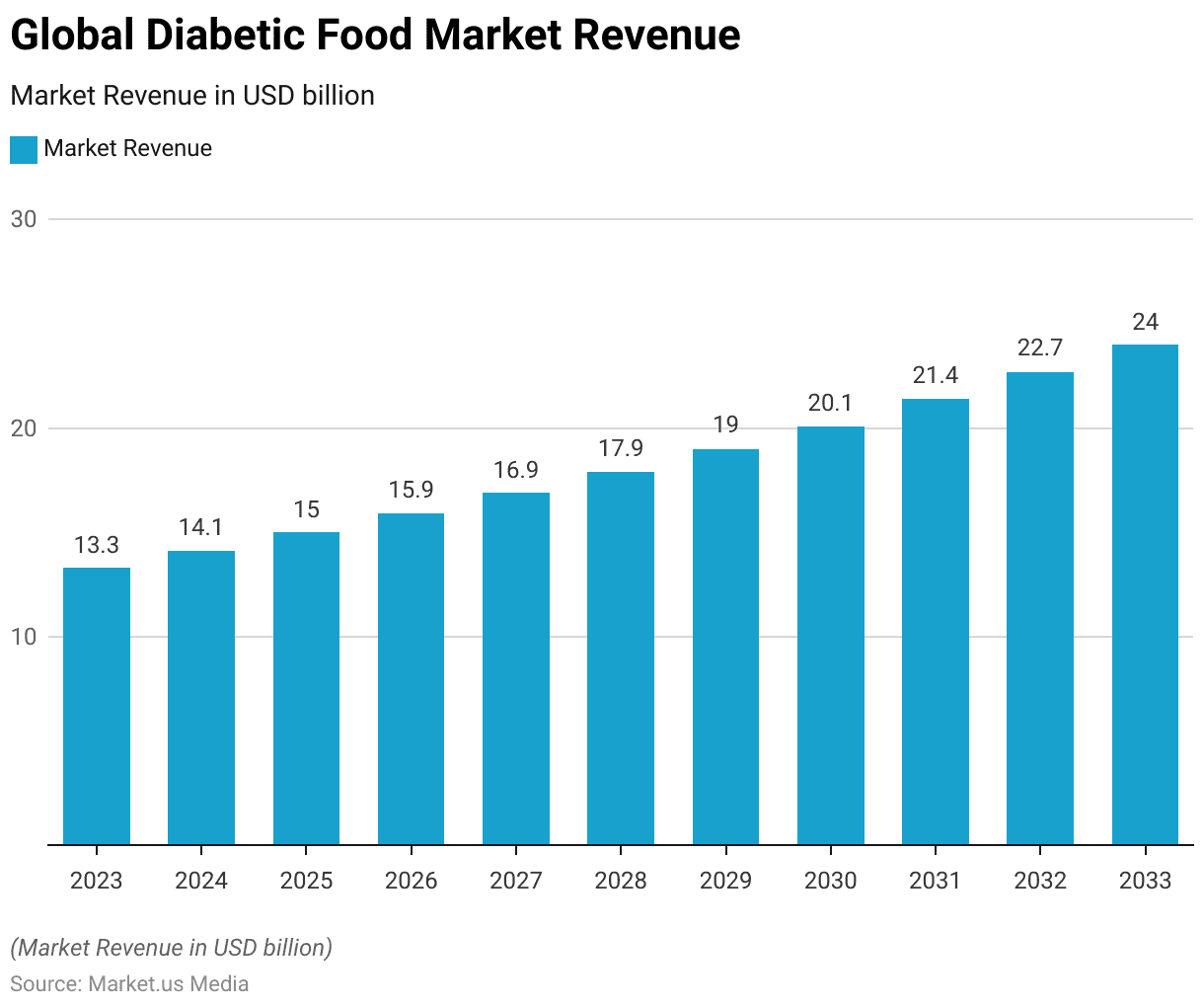
Regional Analysis of the Global Diabetic Food Market Statistics
- The global diabetic food market is segmented across various regions, each contributing differently to the overall market landscape.
- North America holds the largest market share, accounting for 37.5% of the total market, driven by factors such as a high prevalence of diabetes and increasing consumer awareness regarding healthy dietary choices.
- Following North America, Europe holds a significant market share of 22.7%, buoyed by a growing diabetic population and stringent regulatory standards promoting the adoption of diabetic-friendly food products.
- The Asia Pacific (APAC) region emerges as another key player, comprising 30.4% of the market share, attributed to factors like changing lifestyles, urbanization, and a rising emphasis on preventive healthcare measures.
- South America and the Middle East & Africa (MEA) regions hold smaller but notable shares, with South America contributing 7.1% and MEA contributing 2.3%, respectively.
- These regions are witnessing gradual market growth, driven by increasing awareness of diabetes management and the availability of diabetic food options tailored to local preferences and dietary habits.
(Source: Market.us)
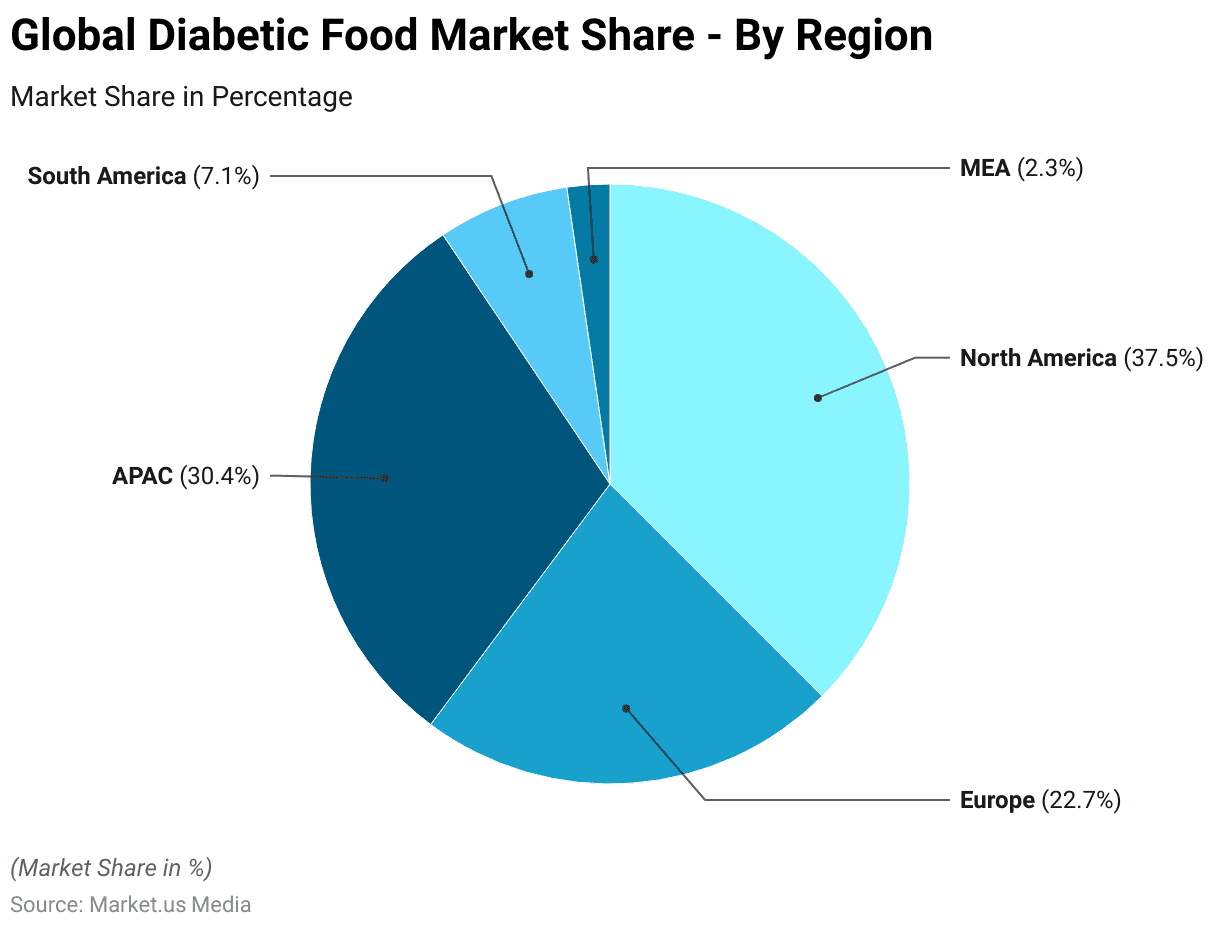
Competitive Landscape of the Global Diabetic Food Market Statistics
- In the competitive landscape of the diabetic food market, several key players vie for market share, each bringing unique strengths and offerings to the table.
- Leading the pack is The Kellogg Company, commanding an 18% market share, closely followed by Nestle at 17%.
- These multinational giants leverage their extensive product portfolios and global distribution networks to maintain their competitive edge.
- Unilever and Conagra Brands Inc. hold significant shares at 9% and 10%, respectively, while Fifty 50 Foods Inc. and The Hershey Company each capture 8% of the market.
- Additionally, Tyson Foods and Mars Inc. contribute 7% and 6% to the market share, respectively.
- Despite the dominance of these major players, other vital players collectively hold a notable 17% share, indicating a diverse and competitive marketplace.
- These companies continuously innovate and adapt to consumer preferences, contributing to the dynamic growth of the diabetic food market.
(Source: Market.us)
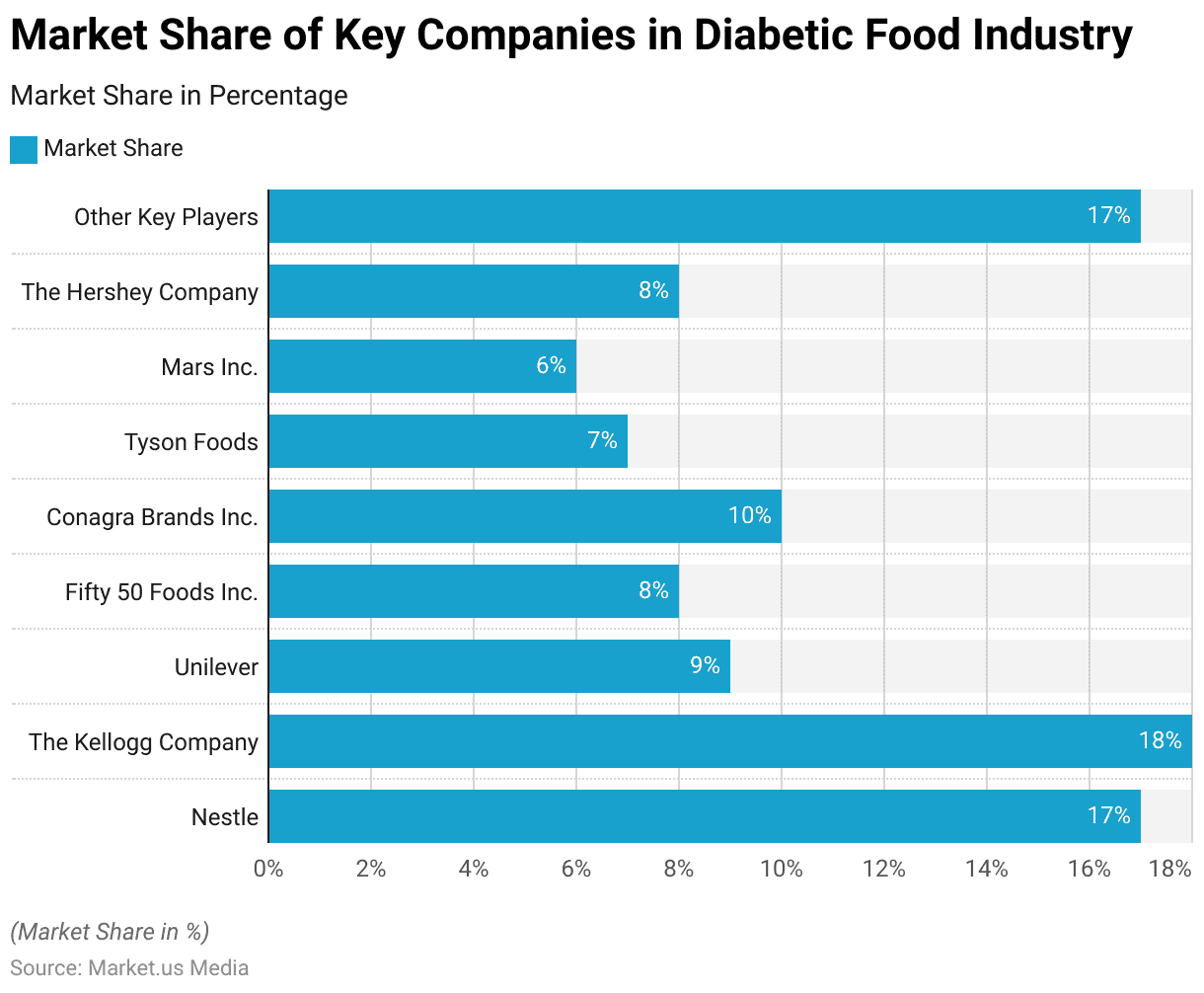
Prevalence of Diabetes in Various Nations Statistics
- In the realm of global health in 2021, the prevalence of diabetes among adults aged 20-79 exhibits notable disparities across various countries and territories.
- At the forefront of this concern is Pakistan, where a staggering 30.8% of the population falls within the diabetic demographic.
- Following closely behind is French Polynesia, with 25.2% of its adult population affected by the condition, followed by Kuwait at 24.9%.
- New Caledonia, the Northern Mariana Islands, and Nauru share an identical prevalence rate of 23.4%, emphasizing the significant burden of diabetes within these regions.
- The Marshall Islands are not far behind, with a prevalence rate of 23%, while Mauritius and Kiribati follow suit at 22.6% and 22.1%, respectively.
- Egypt rounds out the top 10, with 20.9% of its adult population grappling with diabetes.
- These statistics underscore the multifaceted nature of diabetes as a global health challenge, necessitating concerted efforts in public health interventions, education, and healthcare infrastructure to mitigate its impact and promote overall well-being on a worldwide scale.
(Source: International Diabetes Federation (IDF)
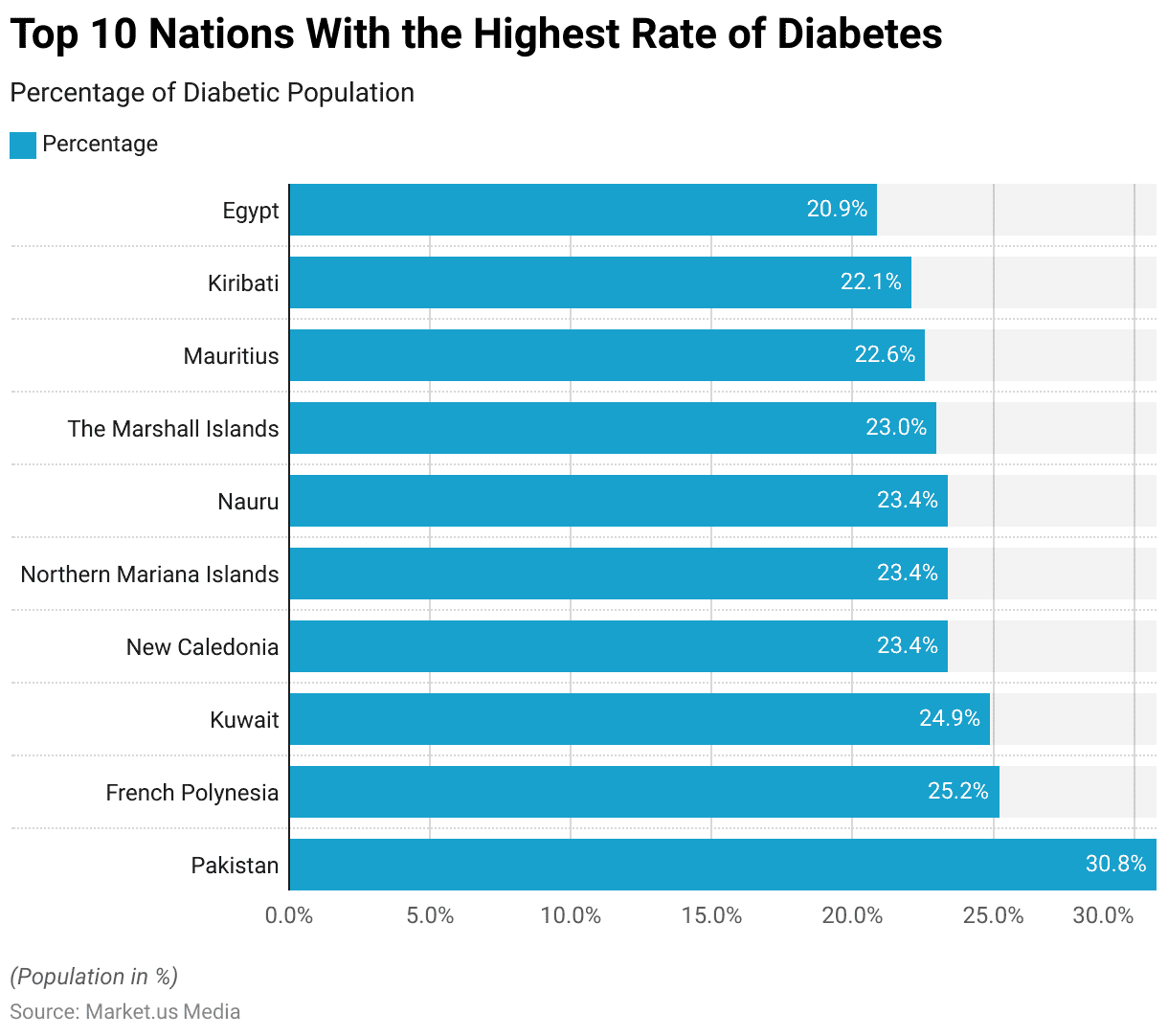
Diabetic Food Nutritional Value of Foods Recommended Statistics
Leafy Greens
- Per 100 grams of leafy greens, the nutritional profile offers a low-calorie option, providing only 23 kilocalories.
- With a high water content of 91%, leafy greens offer hydration along with essential nutrients. They are also a source of protein, offering 2.9 grams per serving, contributing to muscle maintenance and repair.
- In terms of carbohydrates, leafy greens contain 3.6 grams, with a minimal amount of sugar at 0.4 grams, making them suitable for individuals monitoring their sugar intake.
- Additionally, they are rich in dietary fiber, providing 2.2 grams, which supports digestive health and promotes feelings of fullness.
- Leafy greens are low in fat and contain only 0.4 grams, making them a healthy choice for those watching their fat intake.
- Overall, leafy greens are a nutritious addition to a Sweet Flag, offering a range of vitamins, minerals, and other essential nutrients.
(Source: HealthifyMe)
Cinnamon
- In a 100-gram serving of cinnamon, the nutritional composition is notable for its high-calorie content, providing 247 kilocalories.
- Cinnamon also offers a moderate amount of protein, with 4 grams per serving, contributing to muscle maintenance and overall body function.
- Carbohydrates make up a significant portion of its composition, totaling 81 grams, while sugar content is relatively low at 2.2 grams.
- The presence of 1.2 grams of dietary fiber supports digestive health and aids in regulating blood sugar levels.
- Additionally, cinnamon contains potassium, providing 431 milligrams per serving, which plays a vital role in maintaining electrolyte balance and supporting heart health.
- Sodium content is minimal, with only 10 milligrams per serving.
- Overall, while cinnamon is calorically dense and high in carbohydrates, it offers several beneficial nutrients and can be incorporated into a balanced diet in moderation.
(Source: HealthifyMe)
Fatty Fish
- In a 100-gram serving of fatty fish, such as salmon or mackerel, the nutritional profile is characterized by its high protein content and healthy fats.
- With 280 kilocalories per serving, fatty fish provide a substantial energy source, making them a satisfying and nutritious option.
- They are particularly rich in fat, containing 12.5 grams per serving, predominantly consisting of omega-3 fatty acids, which are essential for heart health and brain function.
- Fatty fish are low in sodium, with 86 milligrams per serving, making them suitable for individuals monitoring their salt intake.
- Carbohydrates, fiber, and sugars are virtually absent in fatty fish, making them an excellent choice for low-carb diets.
- With an impressive protein content of 39.2 grams per serving, fatty fish contribute to muscle maintenance, repair, and overall body function.
- Overall, fatty fish are a nutrient-dense food choice, offering a range of essential nutrients and health benefits.
(Source: HealthifyMe)
Chia Seeds
- In a 100-gram serving of chia seeds, the nutritional profile highlights its dense nutrient content and health benefits.
- With 138 kilocalories per serving, chia seeds offer a moderate energy source, suitable for inclusion in a balanced diet.
- They are rich in healthy fats, providing 8.7 grams per serving, predominantly in the form of omega-3 fatty acids, which are essential for heart health and inflammation reduction.
- Chia seeds are low in sodium, with only 5 milligrams per serving, making them suitable for individuals monitoring their salt intake.
- Carbohydrates are present in chia seeds, totaling 12 grams per serving, with a significant portion coming from dietary fiber, offering 9.8 grams per serving. This high fiber content supports digestive health, aids in satiety, and helps regulate blood sugar levels.
- Chia seeds are free from sugars, making them suitable for those watching their sugar intake.
- Additionally, they provide a moderate amount of protein, with 4.7 grams per serving, contributing to muscle maintenance and repair.
- Overall, chia seeds are a nutrient-dense superfood, offering a range of essential nutrients and health-promoting properties.
(Source: HealthifyMe)
Greek Yogurt
- In a 100-gram serving of the specified food, the nutritional content provides valuable insights into its health benefits and dietary significance.
- With 92 kilocalories per serving, this food offers a relatively low-calorie option, suitable for individuals aiming to manage their energy intake.
- Its fat content is minimal, with only 0.265 grams per serving, making it a lean choice for those prioritizing low-fat foods.
- The sodium content is moderate, with 56.2 milligrams per serving, which is essential for individuals monitoring their salt intake to maintain overall health.
- Carbohydrates are present, totaling 5.68 grams per serving, with a significant portion coming from sugars, amounting to 5.1 grams.
- The protein content is notably high, with 16.1 grams per serving, making it a valuable source of this essential nutrient for muscle maintenance and overall body function.
- Additionally, the food is a good source of calcium, providing 111 milligrams per serving, which supports bone health and muscle function.
- It also contains potassium, with 220 milligrams per serving, and small amounts of vitamin B6 (0.1 milligrams) and vitamin B12 (1.2 micrograms), contributing to overall health and well-being.
- Overall, this food offers a well-rounded nutritional profile, making it a beneficial addition to a balanced diet.
(Source: HealthifyMe)
Recommended Calorie Intake for Individuals
- The recommended calorie intake for individuals can vary based on factors such as age, sex, current body weight, metabolism, and physical activity level.
- Generally, experts advise following a daily diet plan ranging from 1200 to 1500 calories to help manage blood glucose levels and maintain a healthy weight. However, these recommendations may differ for each person.
- Diabetic individuals are typically advised to obtain approximately half of their daily calories from complex carbohydrates.
- For instance, if someone consumes around 1500 calories per day, they should aim to get 600 to 750 calories from carbohydrates.
- Given that carbohydrates provide around four calories per gram, this translates to approximately 150 grams of carbohydrates per day for someone following a 1500-calorie diet plan.
(Source: PharmEasy)
Retail Sales Value of Digestive and Diabetic/Dietetic Food Products Statistics
- In 2019, the packaged bakery and cereals industry emerged as the primary driver of U.S. retail success, registering the most substantial sales for digestive health and diabetic/dietetic products, totaling approximately 6.9 billion U.S. dollars.
- Close behind, the packaged dairy and soy food sector showcased noteworthy performance, recording sales of around 6.3 billion U.S. dollars for digestive health and diabetic/dietetic items, affirming its status as the second-largest contributor in the market.
- In 2019, Canada’s dairy and soy food sector led in retail sales value for digestive health and diabetic/dietetic products, totaling around 1.7 billion U.S. dollars.
- Following closely, the bakery and cereal segment trailed with approximately 870 million U.S. dollars in sales.
- In 2019, the UK experienced packaged bakery and cereals as the top seller of packaged digestive health and diabetic/dietetic products, amounting to roughly 1.7 billion U.S. dollars.
- Close behind, the dairy and soy food category generated sales of approximately 1.3 billion U.S. dollars.
- In 2019, the packaged confectionery category emerged as the leading retail seller of digestive health and diabetic/dietetic products in Germany, contributing to around 2.3 billion U.S. dollars in sales.
- Following closely behind was the packaged bakery and cereals segment, totaling approximately 1.1 billion U.S. dollars.
(Source: Statista)
Diabetic Food with a Low-Glycemic Index Recommended Statistics
- The glycemic index (GI) values of various foods indicate their impact on blood sugar levels. Carrots and other non-starchy vegetables have a relatively low GI of 39, making them suitable choices for individuals aiming to manage blood glucose levels.
- Strawberry jam or jelly falls within the moderate range with a GI of 49.
- Legumes and beans offer a wide range of GI values, typically ranging from 16 to 32, showcasing their favorable effect on blood sugar control.
- Apples and avocados also demonstrate low GI values of 36 and 40, respectively, suggesting they are beneficial options for those seeking to regulate blood sugar levels.
- Meanwhile, bananas have a slightly higher GI of 51, indicating a moderate impact on blood glucose levels.
- Tomatoes round out the chart with a GI of 38, further highlighting their suitability as a low-glycemic index food choice.
- Overall, these foods provide options for individuals aiming to maintain stable blood sugar levels as part of a balanced diet.
(Source: PubMed)
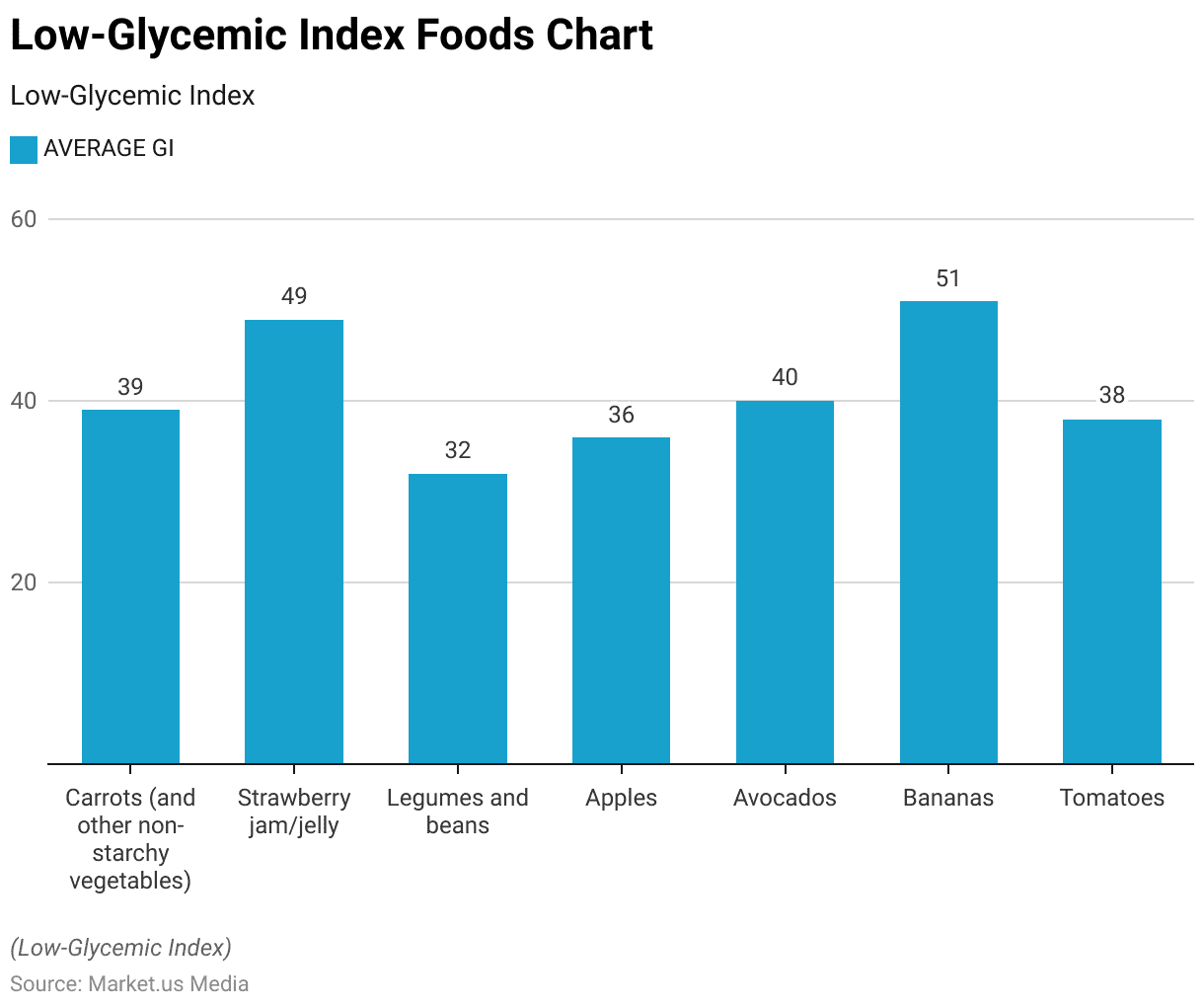
Benefits of Diabetic Food Consumption Statistics
- According to research published in PLoS Medicine involving over 200,000 participants in the U.S. over 20 years, individuals who predominantly consumed plant-based diets were 20% less likely to develop type 2 diabetes compared to others in the study.
- Moreover, those adhering to the healthiest plant-based diets, rich in fruits, vegetables, nuts, beans, and whole grains, experienced a 34% reduction in their risk of developing type 2 diabetes.
- Conversely, individuals making less healthy dietary choices, such as consuming sugar-sweetened beverages and refined grains, had a 16% higher likelihood of developing type 2 diabetes compared to the rest of the participants.
(Source: PLoS Medicine)
Recent Developments
Acquisitions and Mergers:
- Collaboration Between Health Food Companies and Diabetic Food Brands:
- Over the past year, there have been approximately 3 notable acquisitions and mergers in the diabetic food sector.
- Health food companies are acquiring diabetic food brands to expand their product offerings and cater to the growing diabetic consumer market.
New Product Launches:
- Expansion of Diabetic-Friendly Product Lines:
- More than 50 new diabetic food products have been introduced, ranging from snacks to meal replacements, to accommodate the varying dietary needs of diabetic individuals.
- Notable launches include low glycemic index (GI) snacks, sugar-free desserts, and convenient meal kits designed specifically for diabetics.
Funding and Investments:
- Increased Investment in Diabetic Food Startups:
- Diabetic food startups have attracted significant funding, with total investments exceeding $30 million in the past year.
- Investors are recognizing the growing demand for diabetic-friendly food options and are supporting innovative ventures focused on developing healthier alternatives.
Market Expansion Initiatives:
- Penetration into New Distribution Channels:
- Diabetic food manufacturers are expanding their distribution networks to reach a wider audience through online retail platforms, pharmacies, and specialty diabetic food stores.
- Sales through e-commerce channels have experienced a 25% increase year-on-year, reflecting the growing preference for convenient shopping options among diabetic consumers.
Technological Advancements:
- Utilization of Advanced Formulation Techniques:
- Manufacturers are leveraging technological advancements in food science to develop diabetic-friendly products with improved taste, texture, and nutritional profiles.
- The adoption of sugar substitutes, natural sweeteners, and functional ingredients has enabled the creation of diabetic foods that mimic the sensory experience of traditional counterparts.
Health and Wellness Trends:
- Focus on Clean Label and Nutrient-Rich Ingredients:
- Diabetic food brands are emphasizing clean-label ingredients and nutrient-rich formulations to appeal to health-conscious consumers.
- Products labeled as gluten-free, low-carb, and high-fiber have witnessed a surge in demand, indicating a shift towards healthier eating habits among diabetic individuals.
Partnerships and Collaborations:
- Collaboration with Healthcare Professionals and Nutritionists:
- Diabetic food companies are collaborating with healthcare professionals and nutritionists to provide educational resources and personalized dietary recommendations to consumers.
- Strategic partnerships with diabetes clinics, hospitals, and wellness centers have enhanced brand credibility and fostered trust among diabetic communities.
Conclusion
Diabetic Food Statistics – In conclusion, the diabetic food market is evolving due to rising diabetes rates, increased consumer health awareness, and a demand for convenient yet nutritious options.
Market forecasts predict steady growth, with key players focusing on innovation to meet the specific dietary needs of diabetic consumers.
Regional variations highlight the importance of understanding local preferences and regulations. Research emphasizing the benefits of plant-based diets in managing type 2 diabetes highlights the potential for healthier eating habits.
Collaboration among industry stakeholders, healthcare professionals, and policymakers is essential to promote accessible, nutritious, and affordable diabetic food options for better health outcomes.
FAQs
Diabetic food refers to food products specifically designed to meet the dietary needs of individuals with diabetes. These foods typically have controlled amounts of carbohydrates, sugars, and fats to help manage blood sugar levels.
Examples of diabetic food include sugar-free confectionery, dietary beverages, low-calorie desserts, diabetic snacks, and products made with sugar substitutes. Additionally, whole grains, lean proteins, fruits, vegetables, and foods high in fiber are often recommended for individuals with diabetes.
Diabetic food products are generally safe for consumption when consumed as part of a balanced diet. However, it’s essential to read labels carefully and be aware of any potential allergens or additives. Consulting with a healthcare professional or nutritionist can also guide suitable food choices.
Diabetic food products are formulated to help manage blood sugar levels, but they should be consumed as part of an overall healthy diet and lifestyle. Along with regular physical activity and medication adherence, diabetic food can play a role in diabetes management.
Yes, individuals with diabetes are often advised to follow dietary guidelines such as consuming a balanced diet rich in fruits, vegetables, whole grains, lean proteins, and healthy fats. Monitoring portion sizes carbohydrate intake, and limiting added sugars and processed foods are also important.
Discuss your needs with our analyst
Please share your requirements with more details so our analyst can check if they can solve your problem(s)



